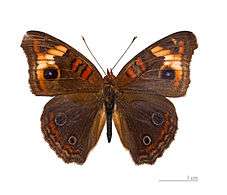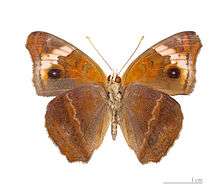Junonia genoveva
Junonia genoveva, the mangrove buckeye, is a butterfly of the family Nymphalidae. The species was first described by Pieter Cramer in 1780. It is found in North America from southern New Mexico, southern Arizona, southern Texas, and southern Florida south through the West Indies, Mexico and Central America to Argentina. Rare strays can be found up to southeastern California, southeastern Colorado and central Florida. In the Cayman Islands, it is known as the Caribbean buckeye.[1]
| Junonia genoveva | |
|---|---|
| On Grand Cayman | |
| Scientific classification | |
| Kingdom: | Animalia |
| Phylum: | Arthropoda |
| Class: | Insecta |
| Order: | Lepidoptera |
| Family: | Nymphalidae |
| Genus: | Junonia |
| Species: | J. genoveva |
| Binomial name | |
| Junonia genoveva (Cramer, [1780]) | |
| Synonyms | |
| |
The butterfly is easily confused with Junonia evarete, the tropical buckeye.[1] Not only have the common names mangrove and tropical buckeye been confused, but the two species of butterflies themselves have been sometimes misidentified in past literature. Recent consensus designates Junonia genoveva the mangrove buckeye and Junonia evarete the tropical buckeye.[2][3][4][5][6]
The wingspan is 45–57 mm.
The larvae have been recorded on Stachytarpheta, Ruellia tuberosa and Blechum in Jamaica. Adults feed on flower nectar.
Subspecies
- Junonia genoveva genoveva (Suriname)
- Junonia genoveva constricta (Venezuela, Colombia)
- Junonia genoveva hilaris (Paraguay, Uruguay)
- Junonia genoveva incarnata (Colombia, Venezuela)
- Junonia genoveva infuscata (Ecuador)
- Junonia genoveva neildi (Central America, Florida (US), Bahamas, Antilles, Puerto Rico)[7]
- Junonia genoveva michaelisi (Central America, Honduras, Florida (US), Bahamas, Antilles, Puerto Rico)[7]
- Junonia genoveva vivida (Guyana, Suriname)
 J. g. genoveva - MHNT
J. g. genoveva - MHNT J. g. genoveva underside - MHNT
J. g. genoveva underside - MHNT
References
- R. R. Askew and P. A. van B. Stafford, Butterflies of the Cayman Islands (Apollo Books, Stenstrup 2008) ISBN 978-87-88757-85-9, pp. 46-51
- Calhoun, John C. (2010). "The Identities of Papilio evarete Cramer and Papilio genoveva Cramer (Nymphalidae), with Notes on the Occurrence of Junonia evarete in Florida" (PDF). News of the Lepidopterists' Society. 52 (2): 47–51.
-
Neild, A. F. E. (2008). "The butterflies of Venezuela. Part 2: Nymphalidae II (Acraeinae, Libytheinae, Nymphalinae, Ithomiinae, Morphinae). A comprehensive guide to the identification of adult Nymphalidae, Papilionidae, and Pieridae". Meridian Publishing. ISBN 978-0-9527657-1-4. Cite journal requires
|journal=(help) - Warren, A. D.; Davis, K. J.; Stangeland, E. M.; Pelham, J. P.; Grishin, N. V. (2017). "Illustrated Lists of American Butterflies (North and South America) 21-XI-2017".
- "Genus Junonia - Buckeyes". BugGuide. Retrieved 24 Jan 2019.
- "Butterflies and Moths of North America". Retrieved 24 Jan 2019.
- Pėrez-Asso, A., Genaro, J. A. & Garrido, O. H. 2009. Las Mariposas de Puerto Rico. Editorial Cocuyo.
External links
- "Junonia genoveva (Cramer, 1782)". Catalogue of the Lepidoptera of the French Antilles. Retrieved September 17, 2019.
- Noctuidae of North America